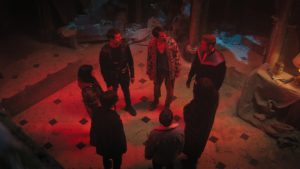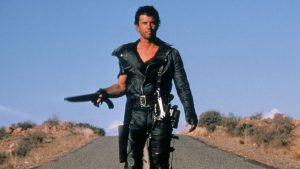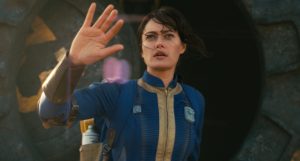
It was the scene I could never watch again while growing up. Yet I did, every time, through cracked fingers and squinted eyes. Like countless children of the ‘90s and ‘80s, it was agonizing to watch Artax, that gallant white horse, sink into literal darkness. But I also never fully looked away. Like Artax, we were drawn toward staring at the abyss and feeling it looking back. The gaze would intensify, too, as the beautiful steed descended further into the murk.
“Everyone knew that whoever let the sadness overtake him would sink into the swamp,” the narrator Bastian (Barret Oliver) reads aloud during the fateful scene in Wolfgang Petersen’s The NeverEnding Story. As much else in the film, Bastian’s onscreen role as a modern child of 1984 reading a book—one titled The NeverEnding Story—acts as a framing device, providing literal storybook exposition and context for the viewer. In this moment, though, he is also a herald; a messenger offering grim warning before the generational trauma is inflicted.
And it was traumatic to watch Artax, the mythical horse and prized companion of the story-within-a-story’s boy hero, Atreyu (Noah Hathaway), sink ever further into the Swamps of Sadness. A look of bewilderment and seemingly real fear seizes the animal’s face, and within seconds, Atreyu goes from gently teasing the beast for being stuck to pleading with it.
“Artax, please,” Atreyu begs into the animal’s ear. “You’re letting the sadness of the swamps get to you. You have to try. You have to care. For me.” But whether he cried, bartered, or eventually just screamed, Atreyu could do nothing as with each passing cut, the horse slipped further into its grave. The echo of “ARRRTAX!” reverberates again and again in the ear of the animal, and the watery eyes of bawling children. Finally, the film fades away from the horse’s panicked face and into black. With the next shot, all that’s left is a weeping child holding a rein to nothing.
Watching the scene even now well into my 30s, this jaded critic cannot be unaffected by a sequence which invites a level of visceral sorrow and anguish that’s virtually alien to modern family films. It also reawakens old memories on the playground of a rumor that lasted for decades until it became the stuff of urban legend: to film this scene, they really drowned a horse.
Anecdotally, I recall the whispers on an elementary school’s basketball court about how they killed “Artax” for real. It was almost as ubiquitous as the alleged “ghost” that you could see for half a second in Three Men and a Baby, or how the word “SEX” can be seen scrawled across the sky when Simba knocks a paw-full of flowers into the night air during The Lion King.
In the days before the internet, the pleasant thing about urban legends and conspiracy theories is that they stayed relatively local: unproven but also unserious; they were campfire gossip shared between friends in passing. And in the case of movies, they made the pictures seem larger and more mythical than really were.
Of course, thankfully in the case of The NeverEnding Story, not a single one of these rumors turned out to be true: there is no ghost in Three Men and a Baby, unless you count Steve Guttenberg’s career. The supposed specter is really just a cardboard cutout of Ted Danson’s actor-character within the movie, which had accidentally been left in the frame of that shot; the long since deleted easter egg slipped into the original cut of The Lion King (and which can still be found on original VHS printings) was “SFX,” amounting to perhaps an ill-advised pat-on-the-back by some of Disney’s special effects animators; and no horses were drowned on the set of The NeverEnding Story.
Nevertheless, the legend persisted for years, and even well into the early wild west days of the internet where in online forums like this one, strangers would say with utter conviction to one another that “the horse from ‘The Neverending story’ actually died while they were filming that incredibly sad scene where ‘Artax’ drowns… We all witnessed the real death of the horse.”
One of the benefits of the modern age is thus being able to refute these notions, as the filmmakers behind The NeverEnding Story did during a 2019 oral history with Entertainment Weekly.
“The horse did not really die despite what has been said throughout the years,” Petersen said before his own passing in 2022. “First of all, we had two identical horses that played Artax. They were so beautiful. They were trained for a long, long time by a professional horse handler with this impossible task for a horse to, without resistance, sink slowly down in the mud all the way up to their head. It did not go over their head, no horse would ever do that.”
It apparently took months to train one or both “Artax” performers to rehearse the scene, and if you notice the film does indeed never show Artax’s head go beneath the bog; we simply see it resist a boy trying to pull on its mouth with all his strength. Hathaway also vividly recalled filming that tug of war to EW.
“I feel like I sent people to therapy over that scene with Artax,” the actor said. “The horse they used was really wonderful and they spent a couple of months teaching her to be ok with being up to her neck with water. That’s something unfamiliar for them. So the way we did that scene was that they had this little elevator under the water that slowly dropped the horse lower and lower. When it got to its chin area, we’d cut the scene. That one scene took over two and a half weeks… [but] they were more careful with that horse than they were with me! I got hurt a hell of a lot more. The horse was definitely looked after well.”
Like so many urban legends and behind-the-scenes gossips that are shared like the holy word, the Artax tall tale is completely made up—almost quaintly so considering the movie noticeably cuts before showing the horse underwater. Yet its enduring quality speaks to a few things both lost and gained by our collective culture today.
In its own weird way, this rumor is a compliment to Petersen, Hathaway, and everyone who worked on The NeverEnding Story. The scene in the movie is so effectively sad and despairing that it left a permanent mark on the psyche of Gen X and “elder” millennial children everywhere. With the simplicity of a fairytale, the sequence provides a safe space to introduce the idea of depression, sadness, and even death to a child. While many of the film’s intended audience were hopefully too young to understand true mortality, the loss of Artax mirrors the death of a beloved pet they might be familiar with, and allows them to grapple with those emotions in a setting that also has a happy ending (spoiler: Artax comes back at the end!).
The scene engrosses the viewer in the stakes of Atreyu’s mission—his horse died!—while also providing a cathartic release of emotions in a fantasy setting. Even by ‘80s kids movies standards, the death of Artax is fairly brutal, but not that much more than when Old Yeller was put down a generation earlier, or when Mufasa died in the aforementioned The Lion King a decade later. But because it is near impossible to imagine a modern family film doing a scene like this speaks to something that has been lost.
Ironically, the same might be said of the scene’s ability to spawn an urban legend. In the modern world where the art and craft of moviemaking has been demystified by a thousand entertainment outlets and sites (ahem, guilt as charged), and even more so by social media, the once vast chasm between your everyday life and the day-to-day practicalities and procedures of filmmaking has been bridged. When a perhaps ghoulish rumor about dead horses starts to spread, a quick interview with EW or a dozen other publications can nip whisper campaigns in the bud.
But it has also, curiously, made movies smaller, and the rumors that remain hail from the most malignant corners of social media and the internet: areas where the goal seems to be to actively distort and misinform readers or viewers while generating clicks and engagement of the most malicious kind. Intriguingly, as information has become easier than ever to access, the only urban legends that are left are often created out of a willful desire to misinform; and the goal is no longer to make small talk on a playground or in a dorm room, but rather to feed neverending doom-scrolling in Elon Musk’s own Swamps of Sadness.
We’re not sure if it’s better or worse that it’s so easy to know the truth about what happened to Artax, but the best tribute we can give The NeverEnding Story is that the next time you watch it, you still will be bawling when Atreyu whimpers, “You’re my friend, I love you” to a swiftly vanishing horse.
The post The NeverEnding Story Scene So Traumatic It Damaged a Generation and Birthed a Legend appeared first on Den of Geek.



